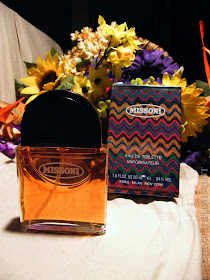ABSTRACT
Mitsouko, the "Mysterious", the Empress of Perfumes.... it's one of the true "legendary" perfumes, produced by Guerlain since 1919.
Superb, immediately recognizable, Mitsouko was subject to many reformulations, including a particularly critical one that took place around 2007-8, which significantly changed the perfume.
For more detailed information about it, I always recommend the extraordinary "Monsieur Guerlain" blog, especially the page about Mitsouko ( here ).
Although the acclaimed critic Luca Turin judged positively this "year 2007 reformulation" (made by Eduard Flèchier), however, a lot of criticism raised, since Mitsouko was no longer "the same as before".
During 2012, perfumer Thierry Wasser claimed to be able to "build" a new version of Mitsouko pretty much like the original, although with great difficulties, due to the even more stringent restriction rules.
In this review we consider five different versions of Mitsouko launched during 15 years, starting from the traditional vintage "Yellow and gold" boxes ( years 1997 and 2003) and three traditional "Pastel" boxes (2009, 2012 and 2013).
All versions are "Eau de Toilette", except the last one (year 2013), which is an Eau de Parfum.
The goal of the "blind test" is: will the stronger (EDP) version be able to stay "on par" at least with the "vintage" EDT? It's a very difficult task, since restriction laws really butchered a lot of perfumes.....
(SEE PICTURES)
( note: to understand Guerlain batch-numbers, see here )
 |
| Year 1997: presumably still a Jean-Paul Guerlain's version. |
 |
| The Eduard Flèchier's version |
 |
 |
| The Thierry Wasser's EDP version. |
 |
| Mitsouko 5-batches blind test (1997-2013) |
RESULTS:
There are no significant differences between year 1997 and year 2003 samples: it's original Mitsouko.
On the contrary, there is significant difference between the one from 2009 and all others.
The 2009 version is "darker and dirtier"; it's not a bad one, but it seems a sort of "flanker", instead of the "original" Mitsouko.
The 2012 EDT version *could* resemble the vintage one, but it seems a bit lighter.
Finally, the 2013 EDP is very similar -although not exactly identical- to the vintage EDT.
CONCLUSIONS
Positives: year 2013 Mitsouko can stay on par with the before-2000 version. Although not exactly identical, differences are minimal. If the most important thing for you is to obtain a "like-vintage" version, the 2013 EDP probably will not disappoint you.
Negatives: to stay "on par" with the old EDT, you need to buy the EDP.
Extra consideration: since perfumes "mature" with age, the vintage EDT could have aged and got even stronger.
Final: as usual, never blind buy an expensive perfume: try yourself before, since your nose will tell you the truth.
In my opinion, a big applause to Guerlain for having nearly restored an immortal classic from the past.
-------------------------------------------------------------------------------------------------------
Mitsouko è uno dei profumi che fanno leggenda a sè, prodotto da Guerlain fin dal 1919.
Superbo, inconfondibile, è stato soggetto a molte riformulazioni, tra le quali particolarmente critica è stata quella avvenuta intorno al 2007-8, che ha mutato in maniera significativa il profumo stesso, per renderlo idoneo alle leggi di restrizione. Per notizie più dettagliate in proposito, raccomando sempre il blog (straordinariamente ben fatto) di "Monsieur Guerlain", nella pagina relativa alle riformulazioni di Mitsouko, che trovate qui.
Sebbene il critico Luca Turin valutasse positivamente questa riformulazione, nondimeno si sono levate molte critiche dal momento che Mitsouko "non era più quello di prima".
Durante il 2012 il profumiere Thierry Wasser dichiarò di essere riuscito a "ricostruire " la versione di Mitsouko praticamente simile all'originale pur con mille difficoltà dovute alle leggi di restrizioni vigenti.
In questa review sono state prese cinque diverse versioni di Mitsouko degli ultimi 15 anni, a partire dalla tradizionale scatola "Giallo e oro" (anno 1997 e anno 2003), e tre tradizionali scatole "Pastello" (2009, 2012 e 2013).
Tutte le versioni sono Eau de Toilette, tranne l'ultima del 2013 che è una Eau de Parfum.
L'obiettivo del blind test è: riuscirà la versione del 2013 ad avvicinarsi a quella "vintage"?
(per saperne di più sui numeri di codice di Guerlain, guardare qui )
 |
| Year 1997: presumably still the "Jean-Paul Guerlain" version. |
 |
| The "Eduard Flèchier" version |
 |
 |
| The "Thierry Wasser" version. |
 |
| Mitsouko 5-batches blind test (1997-2013) |
RISULTATI:
Non ci sono differenze significative tra le versioni "1997" e "2003": è sempre Mitsouko, l'originale.
Al contrario, vi è differenza significativa tra la versione 2009 e tutte le altre.
La versione 2009 è "dark", non è malvagia, ma sembra una sorta di "flanker" di Mitsouko, piuttosto che l'originale. In ogni caso, anche se "dark", continua ad essere riconoscibile.
La versione 2012 EDT *potrebbe* assomigliare al vintage del 1997, ma sembra un pò più leggero, meno persistente.
Infine, il 2013 EDP è molto simile al vintage. Ed è qui che volevamo arrivare. Pur non essendo identica con fedeltà assoluta, nondimeno le differenze sono minime, ma in questi casi entrano in gioco anche altri fattori (maturazione, invecchiamento, conservazione...)
CONCLUSIONI:
Lati positivi: il Mitsouko del 2013, almeno nella versione EDP, può stare alla pari con la versione prima del 2000. Se la cosa più importante per voi era quella di poter comprare di nuovo una versione di Mitsouko "come quella di una volta", l'EDP 2013 probabilmente non vi deluderà.
Lati negativi: per stare alla pari con il vecchio EDT, è necessario acquistare il nuovo EDP....
Considerazione extra: dal momento che i profumi possono "maturare" con l'età, il vecchio EDT potrebbe essere diventato ancora "più forte" di quanto fosse in origine.
Considerazione finale: come al solito, non comprare mai "al buio" un profumo costoso. Provate prima voi stessi, dal momento che sarà il vostro naso a dirvi la verità.
A mio parere, un grande applauso a Guerlain per aver quasi ripristinato un classico immortale del passato.








































